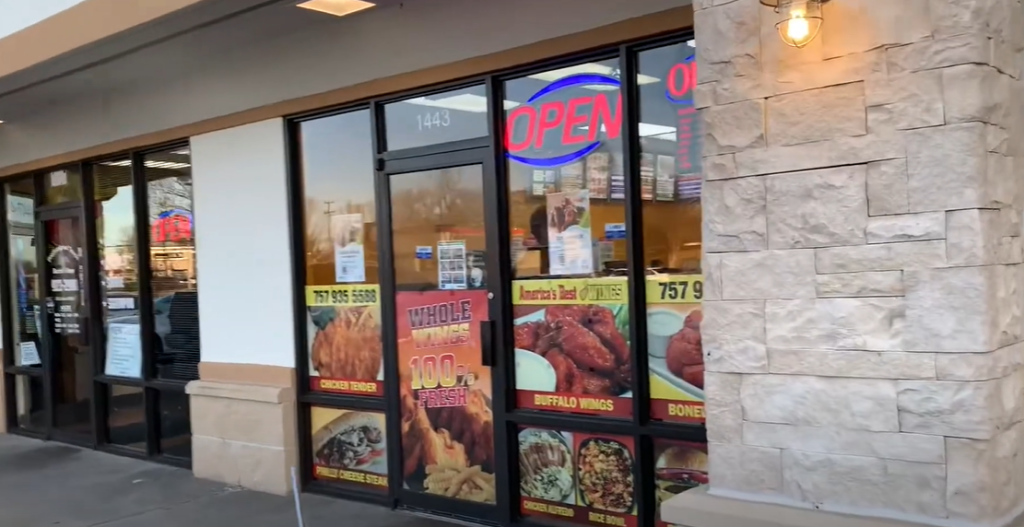Are you looking for America’s Best Wings menu? Look no further. We have compiled a collection of the most delicious wing dishes from across the nation that will tantalize your taste buds and leave you wanting more. With flavors ranging from classic buffalo to sweet honey-garlic, there is something here for everyone. Whether you are craving a spicy kick or a savory treat, our selection is sure to please. So grab your friends and family and come explore all of these amazing flavor combinations – it’s time to experience America’s tastiest wings.
About America’s Best Wings
Established in 2006, America’s Best Wings has been renowned for its diverse menu, offering a wide range of delectable options from seafood and salads to burgers and wraps. Notably, our Buffalo Wings come in various flavors that never fail to satisfy. At America’s Best Wings, we pride ourselves on providing generous portions, affordable prices, and friendly service, ensuring a memorable dining experience. When seeking a fresh, affordable, and delicious dining destination, think no further than America’s Best Wings menu.
America’s Best Wings Menu And Price
| ITEM | PRICE |
| PREMIUM SALADS | |
| Garden Salad | $5.99 |
| Steak Salad | $9.99 |
| Ham Salad | $9.99 |
| Turkey Salad | $9.99 |
| Crispy Tender Salad | $9.99 |
| Grilled Chicken Salad | $9.99 |
| Chef's Salad | $11.99 |
| Catfish Salad | $13.99 |
| Tilapia Salad | $13.99 |
| Grilled Shrimp Salad | $14.99 |
| TRADITIONAL WINGS | |
| 5pc Traditional Wings | $7.59 |
| 10pc Traditional Wings | $13.99 |
| 20pc Traditional Wings | $26.99 |
| 30pc Traditional Wings | $38.99 |
| 50pc Traditional Wings | $61.99 |
| 75pc Traditional Wings | $89.99 |
| 100pc Traditional Wings | $119.99 |
| 200pc Traditional Wings | $239.99 |
| BONELESS | |
| 5 pcs Boneless Wings | $6.59 |
| 10 pcs Boneless Wings | $12.99 |
| 20 pcs Boneless Wings | $24.99 |
| 30 pcs Boneless Wings | $34.99 |
| 10 pcs Boneless Combo | $15.99 |
| WHOLE WINGS | |
| 3 pcs Whole Wings | $6.59 |
| 5 pcs Whole Wings | $12.99 |
| 10 pcs Whole Wings | $24.99 |
| 15 pcs Whole Wings | $35.99 |
| 20 pcs Whole Wings | $46.99 |
| 50 pcs Whole Wings | $99.99 |
| 3 pcs Whole Wings Combo | $9.99 |
| 4 pcs Whole Wings Combo | $12.99 |
| 5 pcs Whole Wings Combo | $14.99 |
| CHICKEN TENDER | |
| 3pc Chicken Tenders | $7.99 |
| 4pc Chicken Tenders | $9.99 |
| 5pc Chicken Tenders | $11.99 |
| 6pc Chicken Tenders | $13.99 |
| 10pc Chicken Tenders | $22.99 |
| SEAFOOD | |
| Grill Salmon Combo | $18.99 |
| Grilled Whiting Combo | $12.99 |
| Grilled Catfish Combo | $12.99 |
| Grilled Tilapia Combo | $12.99 |
| Grilled Flounder Combo | $13.99 |
| 2pc Grilled Fish + 5pc Wings Combo | $19.99 |
| Fried Whiting Combo | $12.99 |
| Fried Catfish Combo | $12.99 |
| Fried Tilapia Combo | $12.99 |
| Fried Flounder Combo | $13.99 |
| 2pc Fried Fish + 5pc Wings Combo | $19.99 |
| Whiting Family Fish | $18.99 |
| Catfish Family fish | $18.99 |
| Tilapia Family Fish | $18.99 |
| Flounder Family Fish | $19.99 |
| 10pc Grilled Shrimp + 5pc Wings Combo | $21.99 |
| Fried Butterfly Shrimp | $7.99 |
| 10pc Fried Shrimp + 5pc Wings Combo | $19.99 |
| 2pc Grilled fish+5pc Grilled Shrimps Combo | $21.99 |
| 2pc Fried fish+5pc Butterfly Shrimps Combo | $21.99 |
| PHILLY CHEESE STEAKS | |
| Steak Philly | $8.99 |
| Chicken Philly | $8.99 |
| Steak & Chicken Philly | $9.99 |
| Shrimp & Steak Philly | $11.99 |
| Shrimp & Chicken Philly | $11.99 |
| Philly + 5pc Wings Combo | $16.99 |
| BURGERS | |
| Cheeseburger | $6.99 |
| Spicy Chicken Sandwich | $6.99 |
| Grilled Chicken Sandwich | $6.99 |
| Turkey Burger | $6.99 |
| Veggie Burger | $6.99 |
| Catfish Burger | $9.99 |
| Tilapia Burger | $9.99 |
| Egg & Fried Bacon Cheeseburger | $9.99 |
| American Jumbo Burger | $9.99 |
| FRESH SUBS | |
| Grilled Chicken Sub | $8.99 |
| Buffalo Chicken Sub | $8.99 |
| Catfish Sub | $9.99 |
| Tilapia Sub | $9.99 |
| Whiting Sub | $9.99 |
| Grilled Shrimp Sub | $11.99 |
| Ham Sub | $7.99 |
| Turkey Breast Sub | $7.99 |
| Chef's Club Sub | $8.99 |
| American Club Sub | $8.99 |
| WRAPS | |
| Steak Wrap | $7.99 |
| Veggie Wrap | $7.99 |
| Grilled Chicken Wrap | $7.99 |
| Chicken Tender Wrap | $7.99 |
| Buffalo Chicken Wrap | $7.99 |
| Club Wrap | $7.99 |
| Catfish Wrap | $9.99 |
| Tilapia Wrap | $9.99 |
| Grilled Shrimp Wrap | $11.99 |
| QUESADILLAS | |
| Cheese Quesadilla | $5.99 |
| Chicken Quesadilla | $7.99 |
| Steak Quesadilla | $7.99 |
| Shrimp Quesadilla | $11.99 |
| Chicken & Steak Quesadilla | $9.99 |
| Chicken & Shrimp Quesadilla | $11.99 |
| Steak & Shrimp Quesadilla | $11.99 |
| BURRITOS | |
| Veggie Burrito | $7.99 |
| Chicken Burrito | $9.99 |
| Steak Burrito | $9.99 |
| Shrimp Burrito | $12.99 |
| Chicken & Steak Burrito | $10.99 |
| Chicken & Shrimp Burrito | $11.99 |
| Steak & Shrimp Burrito | $11.99 |
| SIDE ORDERS | |
| Fries | $3.49 |
| Cheese Fries | $4.99 |
| Potato Wedges | $4.99 |
| Fried Dill Pickles | $4.99 |
| Breaded then deep-fried okra. | $4.99 |
| Coleslaw | $3.99 |
| Dirty Rice | $3.59 |
| Crabsticks | $5.99 |
| Onion Rings | $4.99 |
| Potato Salad | $3.99 |
| Hush Puppies | $4.99 |
| Jalapeño Cheese | $4.99 |
| Mozzarella Sticks | $4.99 |
| Mixed Steam Veggies | $5.59 |
| Fried Mushrooms | $4.99 |
| Cake | $4.99 |
| Salad Dressings | $0.50 |
| 2 oz Wing Sauce | $0.99 |
| 2 oz Dry Seasoning | $0.99 |
| Extra Celery | $0.99 |
| Extra Carrots | $0.99 |
| Carrot/Celery Mix | $0.99 |
| DESSERT | |
| Cheese Cake | $4.99 |
| Carrot Cake | $4.99 |
| Red Velvet Cake | $4.99 |
| Chocolate Cake | $4.99 |

Arises America’s Best Wings Menu
| ITEM | NOTE | PRICE |
| SPECIALS MON TO THUR | ||
| 10 pcs Lunch Special Combo | Monday to Thursday Lunch Specials available until 4PM | $11.99 |
| Cheese Burger + 5pc Wings | $9.99 | |
| Cheese Quesadilla + 5pc Wings Special | $7.99 | |
| SPECIALS MON TO WED | ||
| 10pc Wings + FREE 5pc Wings | A Mon-Wed All Day Special menu: 10pcs Wings + FREE 5pcs Wings | $15.99 |
| KID'S MENU | ||
| Kid's 5pc Chicken Nuggets | The kid's menu includes French fries and a 20 oz drink with each meal | $7.99 |
| Kid's 3pc Boneless Wings | $7.99 | |
| Kid's Cheeseburger | $7.99 | |
| Kid's Hamburger | $7.99 | |
| Kid's 2PC Tenders | $7.99 | |
Program deals of America’s Best Wings
1. Get Up to 50% Off Amazon x America’s Best Wings Deals.
2. America’s Best Wings Flash Sale: Up to 65% Off with Promo Codes (FLASH65).
- Join the savings at America’s Best Wings! Use the ‘FLASH65’ promo code to unlock significant discounts. Simply enter the code at checkout to enjoy your savings. This offer is available exclusively online.
3. America’s Best Wings Coupons: Exclusive Offers & Promo Codes for 2023.
- Looking for great deals from your favorite store? Look no further. Use the ‘FALL’ coupon code from America’s Best Wings Coupons to save big on your next order. Simply enter the code at checkout for a discount. This offer is valid for online purchases only.
4. Exclusive eBay x America’s Best Wings Offer: Enjoy Free Shipping with No Minimum Purchase.
- Limited Time eBay Offer: Free Shipping on Everything – No Minimum Purchase.
America’s Best Wings Ordering Link Information
| Ordering Link Information | |
| Official website | https://americasbestwing.com/ |
| Takeaway menu | https://abwingsva.com/products/items |
| Restaurant address | 315 Garrisonville Rd, Stafford, Virginia 22554 |
| Contact Information | |
| Phone number | (540) 602-2872 or 678-978-2998 |
| [email protected] | |
| Social media | |
| https://www.facebook.com/AmericasBestWingsMD/ | |
| Website | https://www.instagram.com/americasbestwingss |
| https://twitter.com/abwingsmd | |

America’s Best Wings Operating Hours
| Week Days | Operating Hours |
| Monday | 10:00 AM - 11:00 PM |
| Tuesday | 10:00 AM - 11:00 PM |
| Wednesday | 10:00 AM - 11:00 PM |
| Thursday | 10:00 AM - 11:00 PM |
| Friday | 10:00 AM - 11:00 PM |
| Saturday | 10:00 AM - 11:00 PM |
| Sunday | 10:00 AM - 10:00 PM |
FAQ: America’s Best Wings
What are the wing flavors at Americas Best Wings?
Program Deals of America’s Best Wings:
- Lemon Pepper
- Honey BBQ
- Mild/Hot
- Garlic + Parmesan
- Teriyaki
- 24 Karat Gold
What is Moon Dust America’s Best wings?
Moon Dust America’s Best Wings is an exquisite dry rub that is generously sprinkled onto the wings post-frying. Despite its subtlety, this blend of spices offers a delightful combination of citrus and various flavors. Kim aptly compares it to Old Bay; however, Moon Dust boasts a lighter, more refined taste in comparison to the latter.
What are 24k wings America’s Best wings?
The 24k wings at America’s Best Wings are described by Kim as being built around a gold barbecue sauce with a hint of teriyaki. Unlike traditional Buffalo wings, their flavor is more reminiscent of sweet-and-sour. They are served in carry-out boxes, with five wings per container, even if you choose to dine in.
When was America’s Best wings founded?
America’s Best Wings was founded in 2006. We have been bringing everyone to the table since then, offering a wide selection of favorites ranging from seafood and salads to burgers and wraps. And of course, we offer a variety of flavors for our Buffalo Wings.
